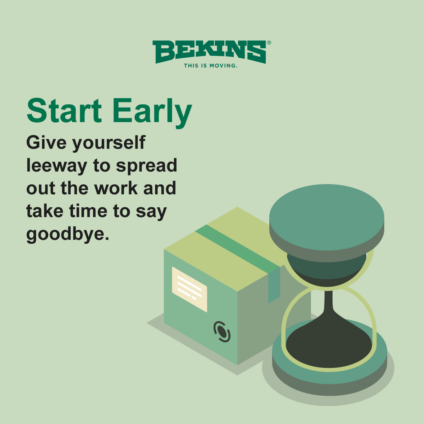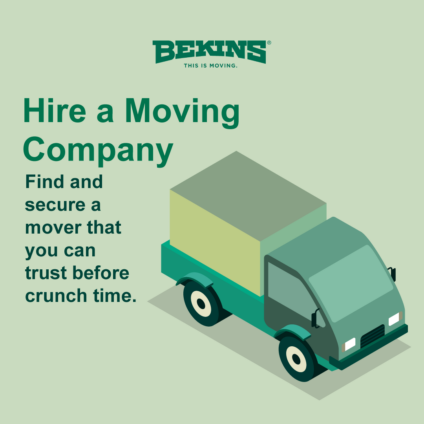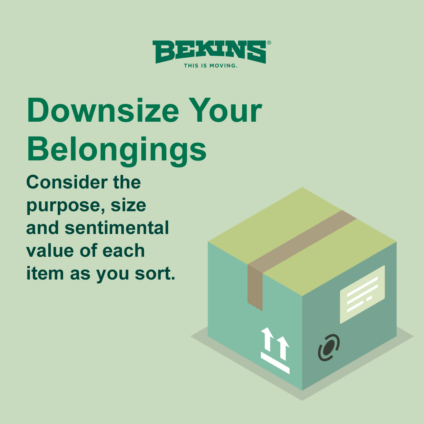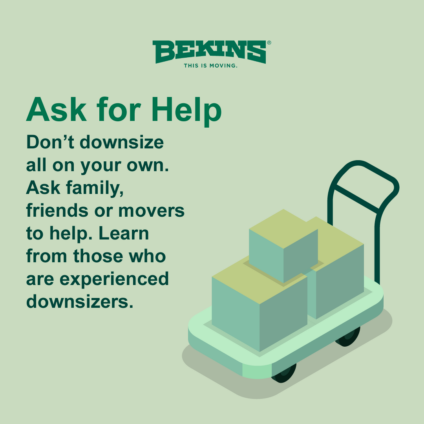- Make a fresh start
- Change careers
- Retire
- Save money
- Reduce property taxes
Whatever your reason, downsizing requires some hard decisions. It means getting rid of possessions or swapping them out for smaller models. Change brings opportunity, and downsizing doesn’t mean you have to sacrifice your quality of living. We’ll help you transition to your new life gracefully without sacrificing too much in the process.
Decluttering Tips
Decluttering your home can be a daunting task. Here are some tips to make the work go easier:
1. Begin Early

You may need a lot of time to cut down on clutter, so start as soon as possible—even if it’s just a few things per day. Making tough choices under stress is never healthy and the more you can accomplish before the crunch, the happier your process will be. So, give yourself enough time to decide which possessions you want to keep and which you’ll say goodbye to.
As soon as you secure your new living space, take measurements of each room and closet to establish how much space you’ll have. Your measurements will help you visualize what will fit in your new home.
Start room by room or closet by closet and form your “keep” and “discard” piles. By having a designated staging area, you can revisit your downsizing tasks regularly vs. starting new each time. You’ll thank yourself for starting early and keeping at it little by little.
2. Hire a Moving Company

Getting an early start also means making all the necessary arrangements sooner rather than later. Unfortunately, movers are in high demand these days. Schedule your mover now so you don’t have to worry later.
Not only will securing a trustworthy moving company bring peace of mind on moving day, but you can use your movers as a downsizing resource. At Bekins, we understand what downsizing means. We know your life change is important and we want to make the transition go smoothly.
Bekins is more than just a superb team of people to carry your belongings. We can also help you clear the clutter via packing support, boxes and packing materials and storage when you need it.
3. Downsize Your Belongings

Once you know the size of the space you’re moving into, take an inventory of your belongings and start to divide and conquer. Consider the following factors:
- Purpose and quantity: How much do you use a given item? If you have several pairs of similar shoes or a range of similar tools, try to reduce the number down to one or two. If your new location has one bathroom instead of two, will you still need two sets of towels?
- Sentiment: Even if an item isn’t inherently useful, that doesn’t mean it’s easy to discard. Sentimental items can be difficult to let go of, no matter their utility. One solution is to start passing heirlooms on to other family members. Preserve your connection to special items by keeping them in your family. Digitize photos and documents to save space.
- Size: Your current home’s dimensions are likely larger than those in your new one. Decide which pieces of furniture suit the space and which would look awkward and oversized. Often, less is more—a few well placed pieces of furniture can make a small space feel larger and more inviting. Cramming in too much will only make the space feel cramped.
You may find it helpful to make lists of your items as you sort through them. Then, compare the lists. If you have three winter coats or two dog leashes, you might only need one of each.
4. Make the Hard Decisions and Resist Impulses

Many individuals choose to downsize from a larger home to a smaller one after a major life event, such as a graduation, career change, divorce or retirement. To make it a true fresh start, you’ll need to embrace difficult decisions about what to bring with you in your new life.
As you approach your move, resist the temptation to buy new furniture or purchase a lot of new items. Hold off until you settle into your new living arrangement. Once you know how your existing belongings fit into your space, you can make informed decisions about what to add.
5. Ask for Help

There’s no clear formula for downsizing your home. If you have a friend in a similar situation, see if you can visit their home and ask some questions about it. Notice how others use smaller spaces and take notes. Many TV programs like Legacy List specialize in giving downsizers examples for how to maximize their move.
Reach out to friends and family for help downsizing your home. If you don’t have many helping hands nearby, try a moving company. Hiring someone to pack for you can be a time and life saver! As you pack up and move in, discuss your options with your mover. Consider using a local storage space for some of your possessions and move in with just the essentials. You can bring items out of storage as you need them and decide what you really can’t live without.
6. Find New Homes for Your Stuff

Chances are, there are a lot of people who could use many of the items you don’t need anymore. As you declutter before moving, ask family members and friends if they want any of the things you’re discarding and then consider donating the rest.
But, where are the best places to donate? You can donate books to schools, churches and other organizations that need them. For clothing you can search “clothes donation box near me,” but many organizations will save you the hassle and pick up your things if you have a large donation.
Other organizations to consider donating your things to include:
Donating also provides a nice tax write off, which can come in handy when you’re downsizing.
Start Downsizing Today
Downsizing can be work but it’s also an opportunity for an easier, less encumbered life. If you need help getting started on your big transition, reach out to your local Bekins Agent. We’d love to help you downsize your home without losing any of the quality and comfort you’ve come to depend on.

